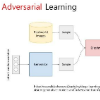Unsupervised domain adaptation(UDA) has been applied to image semantic segmentation to solve the problem of domain offset. However, in some difficult categories with poor recognition accuracy, the segmentation effects are still not ideal. To this end, in this paper, Intra-subdomain adaptation adversarial learning segmentation method based on Dynamic Pseudo Labels(IDPL) is proposed. The whole process consists of 3 steps: Firstly, the instance-level pseudo label dynamic generation module is proposed, which fuses the class matching information in global classes and local instances, thus adaptively generating the optimal threshold for each class, obtaining high-quality pseudo labels. Secondly, the subdomain classifier module based on instance confidence is constructed, which can dynamically divide the target domain into easy and difficult subdomains according to the relative proportion of easy and difficult instances. Finally, the subdomain adversarial learning module based on self-attention is proposed. It uses multi-head self-attention to confront the easy and difficult subdomains at the class level with the help of generated high-quality pseudo labels, so as to focus on mining the features of difficult categories in the high-entropy region of target domain images, which promotes class-level conditional distribution alignment between the subdomains, improving the segmentation performance of difficult categories. For the difficult categories, the experimental results show that the performance of IDPL is significantly improved compared with other latest mainstream methods.
翻译:未经监督的域适应(UDA) 已被应用到图像语义分割法中,以解决域被抵消的问题。 但是,在某些难以识别的类别中,分解效果仍然不理想。 为此,本文件提议了基于动态 Pseudo Labels (IDPL) 的子多域适应对抗性学习分解法。 整个过程包括3个步骤: 首先, 提议了试级假标签动态生成模块, 将全球级和地方级的类匹配信息连接起来, 从而适应性地为每类生成最佳阈值, 获得高质量的假标签。 其次, 以实例信任为基础的子多域分类模块已经构建, 能够动态地将目标域区分为简单和困难的亚域。 最后, 提议了基于自我保护的子多域对抗性辨识性学习模块。 它使用多头自闭式软件, 以有助于生成高质量的假标签, 获得高质量的假标签。 第二, 以实例信任为基础的子域分类模块模块模块模块模块模块模块模块模块模块模块模块模块, 将显著地将目标域内最困难的绩效分类进行升级,, 显示最困难的分类的分类 。



